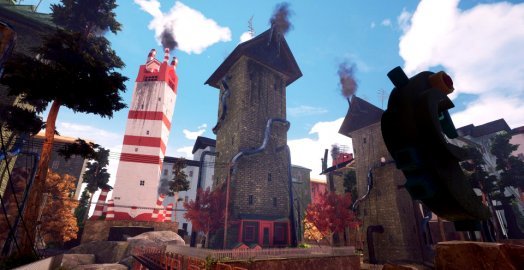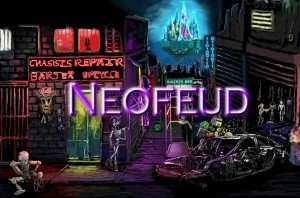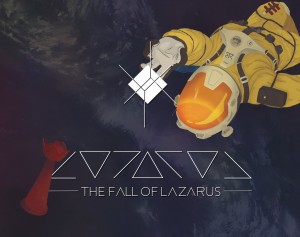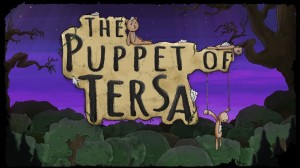Review for ZED

ZED took me by surprise. A first-person, free-roaming adventure developed by Eagre Games and released by Cyan Ventures (the new publishing arm of the Myst franchise), it’s actually quite different than Myst. Its striking 3D surrealism is over-the-top, more dreamlike than habitable. Familiar and bizarre elements sit side-by-side in uncanny landscapes and cluttered rooms. And its obstacles aren’t nearly as head-scratchingly formidable as its iconic inspiration. Instead, each place you visit peels back the onion of elusive memories, leading to flashes of insight, moments of glee, and jabs of pain. If you want to leave the beaten path and take the road less traveled, then ZED is your ticket to ride.
With the horns of a moose, tail of a fox, crocodile snout and hedgehog hair, ZED is a wacky cartoon character. He was conceived by the game’s mysterious protagonist who, as a child, answered to the name of “Peanut.” As a young man, Peanut collaborated with his friend Mal to produce graphic novels that went on to nationwide renown. Our hero is now approaching the end of his life, facing severe memory retrieval symptoms. He is anxious about this condition, partly because it is keeping him from finishing a book he is writing for someone named Charlotte. His doctor recommends a computer game that may help solve the recall-processing problem. What the player experiences is a series of visions that pull images from Peanut’s past, remembered as fragments that can even be somewhat contradictory – pretty much the opposite of realistic flashbacks. These compact scenes work to solidify his memory, but also raise questions about previous events, some whimsical, some tragic.
As you wander the surreal locales, you discover new insights into this man’s creative and emotional progress (or lack thereof). You’ll explore an old neighborhood spiffed up for Halloween, tramp through underground sewer-like caverns, and admire realms borrowed from pop culture. Certain elements repeat: schoolbooks, filing cabinets, trophies, bright cartoon drawings, colored pencils. Doors are everywhere – perhaps denoting choices, mistakes, paths taken, opportunities shut off. Much of the scenery is idiosyncratic, but this esthetic diverges from a room framed by marble walls and tiled floor that reoccurs – impersonal and hollow. Other distinctions also surface: some spaces are in black-and-white, others in lively color, and one switches back and forth between the two. Gigantic, solid gears and massive, sneering heads contrast with intricate wall drawings. In a window on a train, the reflection is more vivid than the reality.
Many animated oddities jazz up the gameworld: antennae arms twirl, a sun disk rotates, and fish swim through the air. Ambient sounds fill the silences as machines grind, the wind blows, and children’s laughter echoes faintly. Background music includes a wide variety that suits the changing ambiance: a violin solo adds a touch of pathos, whimsical woodwinds and brass a sense of insouciance, and techno-music an empty loneliness.
Most of the story elements occur in small gulps through the narration and the journal, with the exception of longer texts that are framed and hanging on the wall in the first room you encounter. It takes a while to read these initial texts, but they are clearly worth it and set the tone well. Your guides on the journey are two aspects of the hero’s mind, Mr. Id and Mr. Ego, neither of whom you ever see (though certain masks are quite suggestive). At the beginning of each memory, these two briefly argue and joke, tease and explain, celebrate and regret, and you can move around and explore as they talk. The phrasing and quirky descriptions evoke different eras that fit the scenery, and the voice-overs are extremely effective.
As bits and pieces of the story fell into place, I found myself wholly drawn into the narrative, wondering what the finale would be – would it tip toward the tragic or end in bliss? The way the story unfolds also made me examine my own priorities. What is most important in life? Family? Career? Friends? Our lives are tick-tocking away with every moment we experience, so which of these priorities give way when time is limited?
Gameplay is minimal, suiting the prominence of the plot and not bogging you down with long periods of being stuck. (Puzzle mavens, consider yourselves forewarned: you won’t find any labyrinths or tone-matching or intricate mechanical conundrums here.) Each memory has a few items that you must discover but these are usually easy to find, as the object’s outline is illuminated. Clicking on one triggers a brief illustrated journal entry, and you can’t leave a memory location until you’ve found them all. When you’ve located the necessary items, a tile-based jigsaw puzzle appears across one of the doors. You simply point and click to swap the pieces into their correct position, and then exit.
For a more difficult challenge, each memory also contains four stuffed animals that have a connection to ZED’s patchwork body parts. These “fluffies” are sometimes mischievously well hidden. I doff my hat to any gamer who manages to find them all. Click on one in the environment and it acknowledges you with a squeak. Fortunately, it isn’t necessary to detect all of them in order to progress.
Played from a first-person perspective, movement is controlled via gamepad thumbsticks or the WASD keys with the mouse handling the camera. There is no inventory. The game uses autosave only, and the checkpoints kick in at the beginning of each new memory. If you collect journal-linked items and then exit the game before solving the jigsaw puzzle, the entries remain in the journal, but you’ll have to re-collect those objects in order to trigger the puzzle that opens the door.
While I completed the game on a standard PC monitor, ZED was actually designed with VR in mind, though playing that way comes with both benefits and drawbacks. The former is obvious: it’s far more immersive to be surrounded on all sides (and above) by a complete virtual environment, which is especially impressive in some of the grander outdoor environs. The downside is that to enjoy these views, the controls are a bit cumbersome, at least on Oculus Rift. You can still play comfortably sitting down, but sacrificing the free-roaming movement of the standard version, navigation in VR through the Rift touch controllers can only be done through incremental movements and turns, which is both more tedious and far more finicky. It’s easy to get disoriented in the labyrinthine underground sewers with all their narrow twists and turns, especially given the game’s propensity to turn you completely around after going up and down stairs for no apparent reason. Hotspots (other than the main memory items) aren’t indicated either, so you’re forced to do a bit of random clicking if you want to enjoy some of the extra interactions, though these tend to be few and far between. It’s worth checking out in VR if you have the necessary hardware, but don’t shy away from the game if you don’t, as it’s certainly not a requirement or even a definitive improvement.
It took me five hours, exploring in leisurely fashion, to make my way through this brilliant, unpredictable, fantastical world. You won’t find heavy-duty puzzling here, but there’s enough interaction, including the optional discovery challenge, to keep you engaged. Untangling memories gradually and compellingly reveals the story and various character twists. By the end you will have a sense of the highs and lows and the amazing risks that buffet an artist’s life. Recollections are often fickle, but here the fragments come together in a most convincing way. ZED’s triumphs and tragedy will not be easy to forget.
VR contribution to this article by Jack Allin.
WHERE CAN I DOWNLOAD ZED
ZED is available at:
We get a small commission from any game you buy through these links (except Steam).Our Verdict:
Although light on actual gameplay, ZED is a quirky, beguiling exploration of character where fragments of memory spawn an imaginative journey through the haunts and grottos of the mind.




























